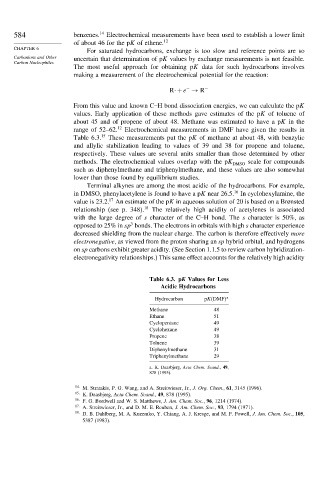Page 602 - Advanced Organic Chemistry Part A - Structure and Mechanisms, 5th ed (2007) - Carey _ Sundberg
P. 602
584 benzenes. 14 Electrochemical measurements have been used to establish a lower limit
of about 46 for the pK of ethene. 12
CHAPTER 6
For saturated hydrocarbons, exchange is too slow and reference points are so
Carbanions and Other uncertain that determination of pK values by exchange measurements is not feasible.
Carbon Nucleophiles
The most useful approach for obtaining pK data for such hydrocarbons involves
making a measurement of the electrochemical potential for the reaction:
−
R·+e → R −
From this value and known C–H bond dissociation energies, we can calculate the pK
values. Early application of these methods gave estimates of the pK of toluene of
about 45 and of propene of about 48. Methane was estimated to have a pK in the
range of 52–62. 12 Electrochemical measurements in DMF have given the results in
Table 6.3. 15 These measurements put the pK of methane at about 48, with benzylic
and allylic stabilization leading to values of 39 and 38 for propene and toluene,
respectively. These values are several units smaller than those determined by other
methods. The electrochemical values overlap with the pK DMSO scale for compounds
such as diphenylmethane and triphenylmethane, and these values are also somewhat
lower than those found by equilibrium studies.
Terminal alkynes are among the most acidic of the hydrocarbons. For example,
16
in DMSO, phenylacetylene is found to have a pK near 26.5. In cyclohexylamine, the
17
value is 23.2. An estimate of the pK in aqueous solution of 20 is based on a Brønsted
relationship (see p. 348). 18 The relatively high acidity of acetylenes is associated
with the large degree of s character of the C–H bond. The s character is 50%, as
3
opposed to 25% in sp bonds. The electrons in orbitals with high s character experience
decreased shielding from the nuclear charge. The carbon is therefore effectively more
electronegative, as viewed from the proton sharing an sp hybrid orbital, and hydrogens
on sp carbons exhibit greater acidity. (See Section 1.1.5 to review carbon hybridization-
electronegativity relationships.) This same effect accounts for the relatively high acidity
Table 6.3. pK Values for Less
Acidic Hydrocarbons
Hydrocarbon pK DMF a
Methane 48
Ethane 51
Cyclopentane 49
Cyclohexane 49
Propene 38
Toluene 39
Diphenylmethane 31
Triphenylmethane 29
a. K. Daasbjerg, Acta Chem. Scand., 49,
878 (1995).
14 M. Stratakis, P. G. Wang, and A. Streitwieser, Jr., J. Org. Chem., 61, 3145 (1996).
15
K. Daasbjerg, Acta Chem. Scand., 49, 878 (1995).
16
F. G. Bordwell and W. S. Matthews, J. Am. Chem. Soc., 96, 1214 (1974).
17 A. Streitwieser, Jr., and D. M. E. Reuben, J. Am. Chem. Soc., 93, 1794 (1971).
18
D. B. Dahlberg, M. A. Kuzemko, Y. Chiang, A. J. Kresge, and M. F. Powell, J. Am. Chem. Soc., 105,
5387 (1983).

